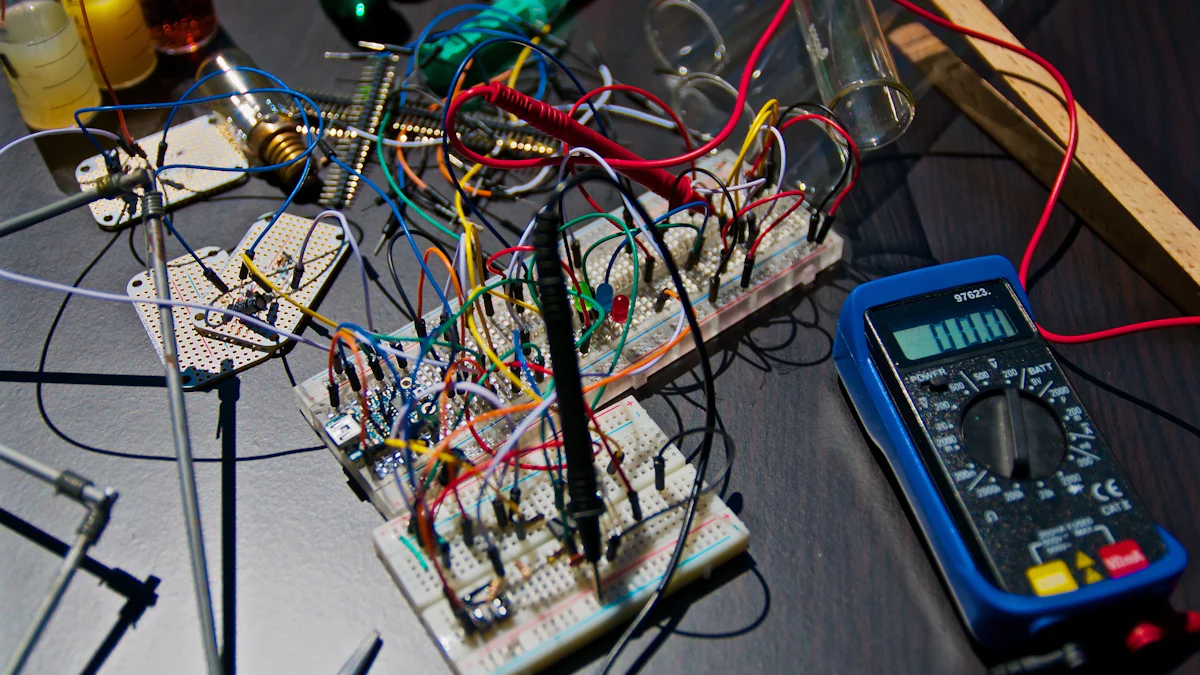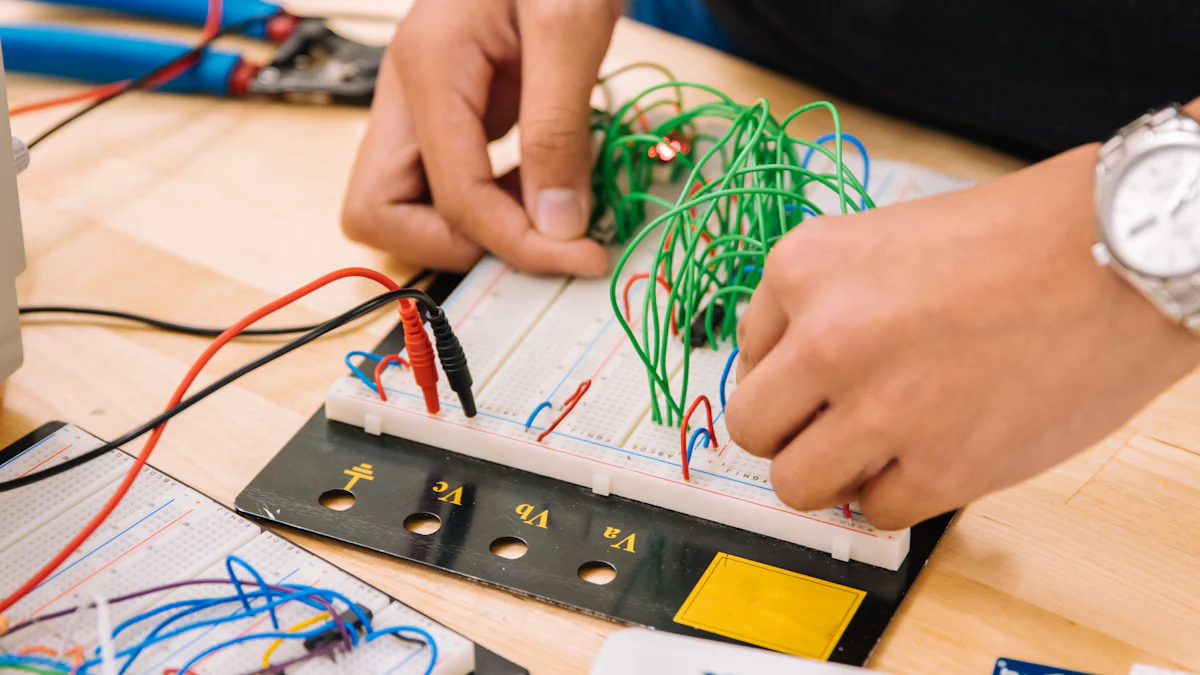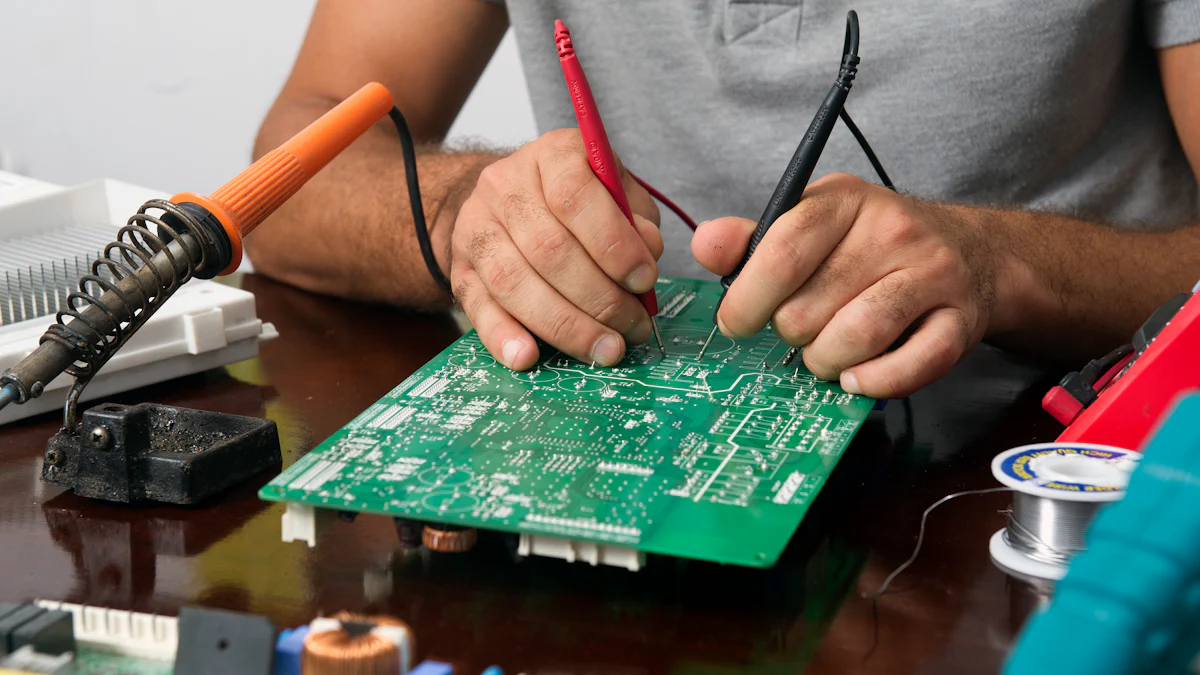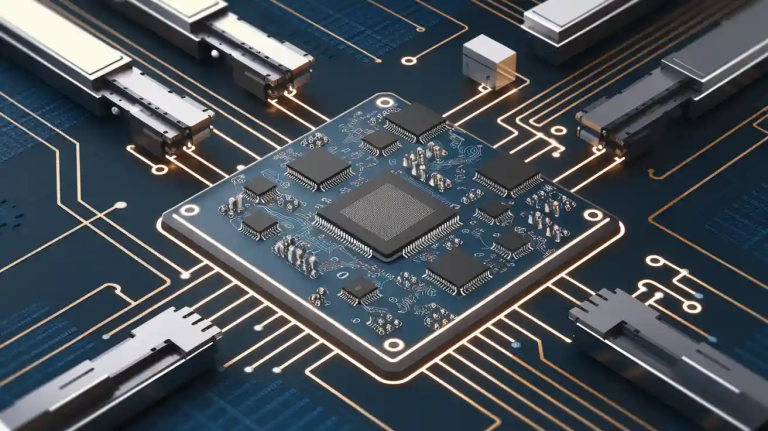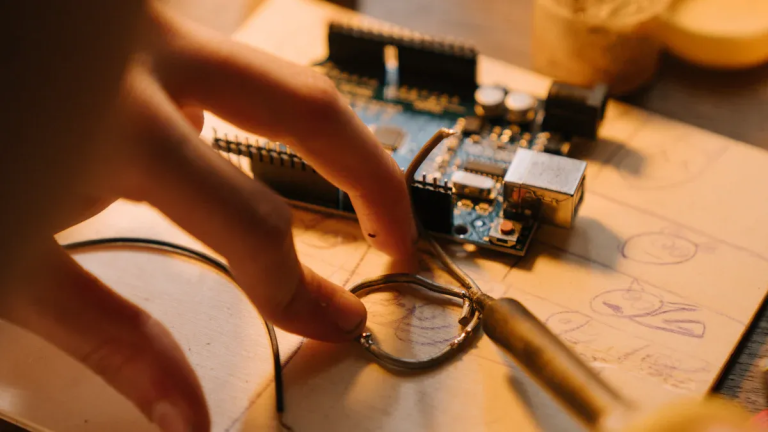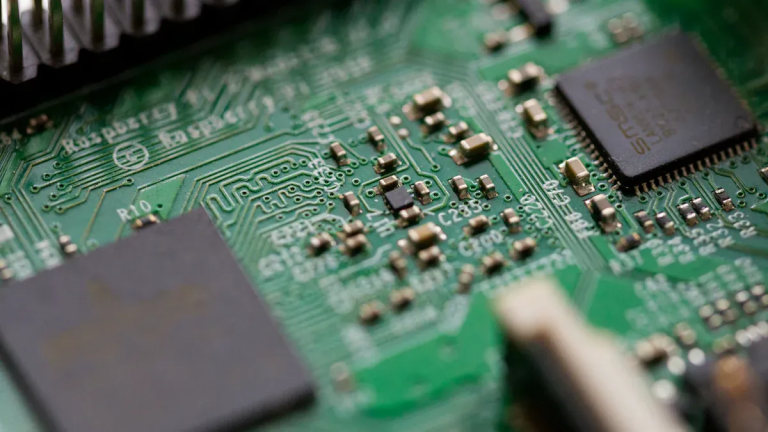Printed Circuit Board Assembly (PCBA) quality validation plays a critical role in ensuring product reliability. Poor-quality PCBAs often lead to performance issues, early failures, and dissatisfied customers. Manufacturers must adopt systematic steps to maintain high standards. Advanced process control techniques, such as statistical process control (SPC), and robust quality management systems have proven effective in improving PCBA quality. Automated inspections, including AOI and X-ray systems, help detect defects early, while adherence to international standards like IPC-A-610 ensures consistent results. These practices safeguard product performance and build customer trust.
Key Takeaways
- Set clear goals to make sure PCBAs are reliable and good quality. Match these goals with industry rules and customer needs for better results.
- Use design for manufacturability (DFM) ideas early on. This lowers production problems and improves the assembly’s quality.
- Use automated tools like AOI and X-ray to find defects early. These tools help check quality and avoid expensive fixes later.
- Use statistical process control (SPC) to watch production steps. This keeps product quality steady and cuts down on waste.
- Keep detailed records of the validation process. This follows rules and helps with future checks and quality reviews.
Preparation Phase
Defining Validation Objectives
Setting clear goals and expectations for the validation process.
Establishing clear objectives is the foundation of a successful printed circuit board assembly validation. These objectives ensure that the PCBA process meets reliability and quality standards. For instance, effective cleaning methods must be verified to maintain consistent cleanliness levels. Standard operating procedures (SOPs) play a critical role in this phase by providing detailed instructions for cleaning tasks. These SOPs ensure compliance with regulatory standards and promote consistency across the validation process.
Aligning objectives with industry standards and customer requirements.
Validation objectives must align with both industry standards and customer expectations. Standards such as IPC-A-610 provide guidelines for assembly cleanliness and soldering quality. By adhering to these benchmarks, manufacturers can ensure that the printed circuit board assembly meets the required performance and reliability criteria. Additionally, understanding customer-specific requirements helps tailor the validation process to deliver a high-quality assembly that satisfies end-user needs.
Design Considerations
Importance of design for manufacturability (DFM).
Incorporating design for manufacturability (DFM) principles into the PCBA process minimizes production challenges. Best practices include:
- Selecting suitable manufacturing processes.
- Evaluating the design for compatibility with production methods.
- Choosing materials based on product requirements.
- Considering the operating environment of the product.
- Ensuring compliance with safety and quality standards.
Collaborating with design engineers early in the development cycle enhances manufacturability. Conducting design validation tests and rule checks further identifies potential issues, ensuring a smoother production process.
Ensuring compliance with industry standards (e.g., IPC standards).
Compliance with IPC standards is essential for achieving consistent quality in printed circuit board assembly. The following table highlights key IPC standards relevant to PCBA design:
| IPC Standard | Purpose | Key Focus Areas |
|---|---|---|
| IPC-A-600 | Visual quality and acceptability of PCBs | Pits, Scratches, Inclusions, Internal defects |
| IPC-6012 | Qualification and performance of rigid PCBs | Electrical, thermal, mechanical properties |
| IPC-A-610 | Quality of electronic assemblies, including PCBs | Assembly cleanliness, soldering, component placement |
| IPC-2221 | Best practices for PCB design | Materials, Layout, Conductor spacing |
| IPC-7711/7721 | Guidelines for rework, modification, and repair of PCBs | Reworking, modifying, and repairing PCBs |
Adhering to these standards ensures that the PCBA process meets industry benchmarks for quality and reliability.
Material Selection
Choosing high-quality components and materials.
Selecting the right components and materials is crucial for a high-quality assembly. Manufacturers should prioritize electrical properties that meet specifications and ensure proper component sizing for accurate placement. Cost management is also essential to maintain cost-effective manufacturing. Quality checks throughout the PCBA process, along with professional testing instruments, help verify soldering quality and connection integrity.
Verifying supplier certifications and reliability.
Reliable suppliers are vital for maintaining quality control in the PCBA process. Manufacturers should request client references and testimonials to assess a supplier’s reputation. Third-party verification services, such as SGS or TÜV Rheinland, can independently confirm a supplier’s legitimacy. Warning signs like a lack of official documentation, unusually low prices, or reluctance to provide samples should be addressed cautiously. Negative reviews or unresolved complaints may also indicate potential risks.
Manufacturing Phase
Soldering Process
Ensuring proper solder paste application.
Solder paste inspection is a critical step in the pcba manufacturing process. Proper application ensures strong and reliable solder joints, which are essential for the functionality of the assembly. Manufacturers must use automated solder paste inspection systems to verify the thickness, volume, and alignment of the paste on the pads. These systems help detect inconsistencies early, reducing the risk of defects during reflow soldering. Regularly maintaining the stencil and ensuring precise alignment during the printing process further enhances the quality of solder paste application.
Monitoring reflow soldering parameters.
Reflow soldering is a key process in pcba manufacturing. Monitoring parameters such as temperature profiles, conveyor speed, and heating zones ensures consistent solder joint quality. Deviations in these parameters can lead to defects like cold solder joints or overheating of components. Advanced reflow ovens equipped with real-time monitoring systems allow manufacturers to maintain optimal conditions throughout the process. Regular calibration of these ovens ensures accurate temperature control, which is vital for achieving reliable soldering results.
Assembly Process
Component placement accuracy.
Accurate components pick and place is essential for ensuring the functionality and reliability of the PCBA. Automated pick-and-place machines equipped with vision systems enhance placement precision by aligning components with the PCB layout. Regular maintenance of these machines minimizes errors such as misalignment or incorrect orientation. Verifying the placement accuracy before soldering reduces the likelihood of assembly defects.
Avoiding common assembly defects (e.g., misalignment, solder bridges).
Assembly defects can compromise the performance of the PCBA. Common issues include misaligned components, solder bridges, and insufficient solder joints. Preventing these defects requires adherence to high-quality control standards and automation of error-prone steps. Targeted employee training also plays a crucial role in minimizing human errors during the assembly process. By addressing potential design, material, and visual defects, manufacturers can significantly improve the overall quality of the assembly.
Process Controls
Implementing statistical process control (SPC).
Statistical process control (SPC) enhances the pcba manufacturing process by using statistical methods to monitor and control production. This approach ensures efficient operations and reduces waste while maintaining product quality. SPC eliminates the need for extensive final inspections by identifying and addressing variations during production. Its adoption has led to reduced costs and improved quality in the industry over time.
Regular calibration of manufacturing equipment.
Calibration of manufacturing equipment is essential for maintaining process control. Instruments critical to measurements or processes require frequent calibration to ensure accuracy. Factors such as instrument type, usage, and industry standards determine the calibration frequency. Regular calibration minimizes deviations, ensuring consistent performance and reliability in the pcba manufacturing process.
Inspection and Testing Phase
Automated Optical Inspection (AOI)
Detecting soldering and assembly defects.
Automated Optical Inspection (AOI) plays a vital role in assembly inspection by identifying defects early in the PCBA process. This non-contact testing method detects a wide range of issues, including surface defects like scratches and nodules, dimensional problems such as shorts and thin solder, and component-related errors like misalignment or absence. AOI also identifies soldering defects, including insufficient or excessive solder joints, solder bridges, and tombstoning. Advanced 3D AOI systems further enhance detection by analyzing package height, coplanarity, and other critical parameters. By addressing these defects promptly, manufacturers can maintain high-quality standards and reduce rework.
Benefits of AOI in early defect identification.
AOI offers several advantages in early defect identification, making it an essential step in quality inspection. Its flexibility allows manufacturers to perform inspections at any stage of production, ensuring consistent quality control. AOI is cost-effective, reducing long-term expenses by improving the pass rate of PCBAs. Additionally, it reliably detects visual defects, such as misplaced components and soldering errors, with high accuracy. These benefits contribute to a streamlined manufacturing process and enhanced product reliability.
X-Ray Inspection
Identifying hidden defects (e.g., voids, solder joint issues).
X-ray inspection is indispensable for detecting hidden defects that are not visible through traditional assembly inspection methods. It identifies issues such as voids, shorts, open solder joints, and pad lifting. For Ball Grid Array (BGA) and Chip Scale Package (CSP) components, X-ray inspection ensures solder ball attachment integrity and detects die damage. It also verifies solder joint quality in connectors and identifies alignment problems in Quad Flat No-lead (QFN) packages. This method provides a comprehensive view of internal structures, ensuring the functionality and reliability of complex assemblies.
Use cases for BGA and other complex components.
X-ray inspection is particularly valuable for validating BGA and other intricate components. It verifies solder ball connections, detects voids and shorts, and ensures no pad lifting occurs. For QFN packages, it inspects J-lead solder joints and confirms proper alignment. In connectors, X-ray inspection checks solder joint quality and identifies bent pins. This technology also screens for hidden solder joint issues in integrated circuits (ICs) and ensures correct placement of passive components. These use cases highlight its critical role in maintaining PCBA quality.
Functional Testing
Verifying electrical performance and functionality.
Functional testing ensures that PCBAs meet electrical performance and functionality requirements. This step evaluates whether the assembly operates as intended under specified conditions. It verifies circuit continuity, signal integrity, and power distribution. In-circuit testing is often employed to check individual components and connections within the assembly. By identifying potential issues at this stage, manufacturers can prevent failures in the final product.
Simulating real-world operating conditions.
Simulating real-world conditions during functional testing provides valuable insights into a PCBA’s performance. Methods such as network emulators replicate various network scenarios, including latency and bandwidth limitations. Traffic shaping tools control network characteristics like packet loss and speed, while proxy servers simulate different network environments. These simulations help manufacturers assess how the assembly performs under actual operating conditions, ensuring reliability and customer satisfaction.
Burn-In Testing
Stress testing to identify early failures.
Burn-in testing subjects PCBAs to prolonged operational stress to identify early failures. This process involves exposing the assembly to elevated temperatures, voltages, and other extreme conditions. By simulating these harsh environments, manufacturers can detect latent defects that might otherwise go unnoticed during standard testing. Early identification of issues allows for immediate corrective actions, reducing the risk of defective products reaching customers.
This testing method also helps predict the lifespan of components. Assemblies with higher failure rates often fail during the initial stages of burn-in testing. Identifying these weak points early ensures that only reliable boards proceed to the next steps of production. Manufacturers benefit from cheaper and easier repairs since addressing defects during this phase is less costly than post-production fixes. This proactive approach enhances overall product reliability and minimizes warranty claims.
Ensuring long-term reliability under extreme conditions.
Burn-in testing plays a critical role in ensuring the long-term reliability of PCBAs. By pushing the assembly to its operational limits, manufacturers gain valuable insights into its performance under extreme conditions. This knowledge allows them to design boards that meet specific customer needs and withstand demanding applications. For example, knowing the temperature thresholds of a board helps manufacturers tailor it for industries like aerospace or automotive, where reliability is paramount.
The benefits of burn-in testing extend beyond reliability. It reduces post-production failures, leading to fewer returns and replacement costs. Preliminary component testing during this phase also identifies potential issues early in the development cycle, stabilizing production and saving time. Ultimately, burn-in testing ensures that PCBAs deliver consistent performance, fostering customer trust and satisfaction.
Final Testing and Validation
Establishing Acceptance Criteria
Defining standards for passing validation tests.
Establishing clear acceptance criteria ensures that the PCBA meets the required performance and reliability benchmarks. These criteria define the minimum standards a product must achieve during testing. Manufacturers often use industry standards, customer requirements, and product specifications as a foundation for these benchmarks. By setting precise standards, they can streamline the validation process and ensure consistent quality control.
Ensuring criteria align with product specifications.
Acceptance criteria must align with the product’s technical specifications and intended application. This alignment guarantees that the PCBA performs as expected under real-world conditions. For example, a PCBA designed for automotive applications must meet stringent thermal and vibration resistance standards. Ensuring this alignment reduces the risk of product failure and enhances customer satisfaction.
Validation Testing
Executing tests on representative samples.
Validation testing involves conducting rigorous tests on representative PCBA samples to evaluate their performance. These samples should reflect the final product’s design and materials. Testing methods include functional testing, environmental stress testing, and in-circuit testing. By focusing on representative samples, manufacturers can identify potential issues before full-scale production.
Measuring outcomes against acceptance criteria.
Measuring testing outcomes against acceptance criteria ensures that the PCBA meets predefined standards. The following table outlines methodologies for effective measurement:
| Methodology | Description |
|---|---|
| SMART Criteria | Ensures criteria are Specific, Measurable, Achievable, Relevant, and Time-bound. |
| MoSCoW Method | Categorizes criteria into Must have, Should have, Could have, and Won’t have. |
| Acceptance Tests | Verifies if the product meets criteria through automated or manual testing. |
| Feedback Loops | Gathers stakeholder feedback to keep criteria relevant and updated. |
| Quality Metrics | Evaluates product quality using quantitative or qualitative measures. |
These methodologies provide a structured approach to assessing validation testing outcomes, ensuring alignment with quality standards.
Data Collection and Analysis
Evaluating results to ensure compliance with standards.
Data collection during validation testing is critical for evaluating compliance with industry and customer standards. Advanced inspection technologies, such as automated optical inspection and functional testing, provide accurate data for analysis. Manufacturers use this data to verify that the PCBA meets all acceptance criteria, ensuring consistent quality.
Identifying areas for process optimization.
Analyzing collected data helps manufacturers identify areas for improvement in the PCBA process. Best practices include early collaboration with design engineers to optimize layouts, maintaining traceability through electronic records, and fostering a culture of continuous improvement. Regular audits and feedback loops further enhance the process, ensuring long-term reliability and efficiency.
Documentation
Recording the entire validation process.
Comprehensive documentation serves as the backbone of the PCBA validation process. It ensures that every step, from initial design to final testing, is meticulously recorded. This practice provides a clear trail of actions and decisions, which is essential for maintaining quality and consistency. Key elements to include in the documentation are:
- Assurance that each PCBA meets specifications through various testing methods.
- Validation of processes where outputs cannot be fully verified, such as soldering or assembly.
- Proper setup of assembly processes, including oven temperature checks and the use of scanning systems or electrical tests.
By capturing these details, manufacturers can demonstrate that the assembly adheres to industry standards and customer requirements. This level of detail also helps identify areas for improvement, ensuring continuous enhancement of the manufacturing process.
Maintaining a clear reference for future audits.
Thorough documentation plays a critical role in supporting future audits and quality assurance efforts. It provides a transparent record of processes, findings, and corrective actions, enhancing accountability within the organization. A well-maintained documentation system offers several benefits:
- It tracks non-conformities, enabling teams to monitor progress and implement corrective actions effectively.
- It ensures transparency by detailing every step of the validation process, fostering trust among stakeholders.
- It serves as a valuable resource for training new personnel, ensuring consistency in operations.
Additionally, detailed records simplify the audit process by offering auditors a clear view of compliance with standards and regulations. This proactive approach minimizes the risk of non-compliance and reinforces the organization’s commitment to quality. By maintaining accurate and accessible documentation, manufacturers can safeguard their reputation and ensure long-term success.
Final Validation and Packaging
Final Assembly
Ensuring all components are securely attached.
The final assembly process ensures that all components are firmly attached to the printed circuit board assembly. Loose or improperly secured components can lead to operational failures or reduced product reliability. Manufacturers use advanced assembly techniques, such as automated fastening systems, to achieve consistent results. Regular quality inspection during this stage verifies that each component is correctly positioned and securely fastened. This step guarantees the durability and functionality of the final product.
Verifying proper labeling and markings.
Proper labeling and markings play a critical role in the final assembly process. Labels provide essential information, such as serial numbers, manufacturing dates, and compliance certifications. These markings ensure that the product meets regulatory requirements and customer specifications. Manufacturers use automated labeling systems to maintain accuracy and consistency. Clear and precise labeling simplifies product identification and enhances traceability throughout the product lifecycle.
Quality Checks
Conducting a final visual inspection.
A final visual inspection serves as the last line of defense against defects before packaging. Trained inspectors or automated systems examine the assembly for visible flaws, such as scratches, misaligned components, or soldering issues. This step ensures that the product meets quality standards and customer expectations. By addressing any remaining defects, manufacturers can reduce the risk of returns or warranty claims.
Reviewing test data and documentation.
Reviewing test data and documentation ensures that the assembly complies with all testing and quality control requirements. This process involves analyzing records from earlier testing phases, such as functional and burn-in testing. Manufacturers verify that all acceptance criteria have been met and that the product is ready for shipment. Comprehensive documentation provides a clear record of the assembly’s journey, supporting future audits and quality assurance efforts.
Packaging
Using anti-static and protective materials.
Proper packaging protects the PCBA from damage during storage and transportation. Anti-static materials, such as bags and foam, prevent electrostatic discharge (ESD) that could harm sensitive components. Static shielding packaging, including metallized bags and conductive boxes, offers additional protection against external static charges. Following ESD procedures alongside these materials ensures effective safeguarding of the assembly.
Ensuring proper labeling for traceability.
Accurate labeling on packaging enhances traceability and simplifies quality control. Labels identify the board’s origins and production history, acting as an early warning system for potential defects. They also improve maintenance efficiency by enabling quick identification of problematic components. Proper labeling increases product reliability by providing insights into production trends and issues.
A systematic approach to PCBA validation ensures consistent quality and reliability in manufacturing processes. Thorough testing and inspection play a pivotal role in identifying defects early, reducing production errors, and enhancing product performance. Effective strategies include collaborating with design engineers, employing advanced inspection technologies, and integrating multiple testing phases. Maintaining accurate traceability records and adhering to international standards further strengthens the validation process.
Adopting best practices for PCBA quality assurance delivers long-term benefits. High-quality assemblies foster customer satisfaction and loyalty, while improved processes reduce rework and operational costs. Compliance with quality standards ensures product reliability, mitigating risks and warranty claims. These practices not only enhance brand reputation but also drive operational efficiency and profitability.
FAQ
What is PCBA, and why is it important?
PCBA stands for Printed Circuit Board Assembly. It is the process of assembling electronic components onto a printed circuit board. High-quality PCBA ensures reliable product performance, reduces failure rates, and enhances customer satisfaction.
How does burn-in testing improve PCBA reliability?
Burn-in testing subjects assemblies to extreme conditions, such as high temperatures and voltages. This process identifies early failures and ensures long-term reliability by simulating real-world operating environments.
Why is compliance with IPC standards critical in PCBA?
Compliance with IPC standards ensures consistent quality and reliability in manufacturing. These standards provide guidelines for soldering, assembly cleanliness, and component placement, helping manufacturers meet industry benchmarks and customer expectations.
What role does automated optical inspection (AOI) play in PCBA validation?
AOI detects defects like misaligned components and soldering issues during production. Early identification of these problems reduces rework, improves efficiency, and ensures high-quality assemblies.
How does proper packaging protect PCBA during transportation?
Protective packaging, such as anti-static bags and foam, prevents electrostatic discharge and physical damage. Proper labeling enhances traceability, ensuring the assembly reaches its destination safely and meets quality standards.


